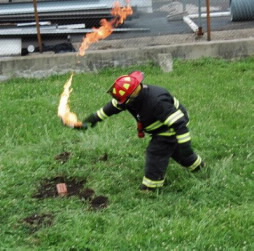EMBARGOED FOR RELEASE | March 25, 2012
Preserving arson evidence with triclosan
Note to journalists: Please report that this research was presented at a meeting of the American Chemical Society
A press conference on this topic will be held at 7 p.m. Eastern Time, March 26, 2012, in the ACS Press Center, Room 15A, in the San Diego Convention Center. Reporters can attend in person or access live audio and video of the event and ask questions at www.ustream.tv/channel/acslive.
SAN DIEGO, March 25, 2012 — A preservative in toothpastes, hand soaps, underarm deodorants and other everyday products is getting a second life, helping crime scene investigators preserve evidence of arson, scientists reported here today at the 243rd National Meeting & Exposition of the American Chemical Society (ACS).
Media Contact
During the meeting, March 23-28, the contacts can be reached at 619-525-6268.
Michael Bernstein
202-872-6042
m_bernstein@acs.org
Michael Woods
202-872-6293
m_woods@acs.org
The preservative, triclosan, would be the first evidence preservative for traces of gasoline and other ignitable fluids, or flame “accelerants,” commonly used in arson, according to John V. Goodpaster, Ph.D., an international expert who reported on evidence of triclosan’s effectiveness.
“We may finally have a substance that enables crime scene investigators to preserve traces of gasoline and other fire starters in the charred remains of buildings long enough to determine whether a fire was arson,” Goodpaster said. “It could not only help law enforcement officials catch criminals, but also reveal the true scope of the arson problem.”
Estimates already rank arson, the intentional starting of a fire, as the leading cause of fires in the U.S. Arson is involved in an estimated 267,000 fires each year; causes 475 deaths and 2,000 injuries and almost $1.5 billion in property damage. Those figures, however, may be an underestimate, Goodpaster said.
“Because of the huge backlog in law enforcement labs today, evidence often sits on a shelf for weeks or months until a laboratory technician has time to analyze it,” he explained. “By then, any traces of gasoline or other accelerants may disappear due to the action of soil microbes that break down those materials. Currently, the only way to preserve this evidence is to freeze it, but freezer space in crime labs often is limited.”
Goodpaster, who is with Indiana University-Purdue University Indianapolis, traces the idea for enlisting antimicrobials as arson fighters to concerns expressed by staff at the Indiana State Police Laboratory in Indianapolis. They knew that microbes were degrading suspected arson samples and could tell that gasoline was probably in a particular sample. But the gasoline was so degraded that they couldn’t draw a definitive conclusion.
Searching for a solution to the problem, Goodpaster and graduate student Dee Ann Turner began testing various antimicrobial agents as preservatives. Those agents ranged from household chlorine bleach to iodine to hydrogen peroxide. Finally, they tested triclosan, which is in many consumer products, such as antibacterial hand soaps, toothpaste and even furniture and toys.
“We decided to try it, and lo and behold, it was tremendously effective,” said Goodpaster.
Under the supervision of the Indianapolis Fire Department, Goodpaster and Turner threw Molotov cocktails — bottles of gasoline that shatter on impact in a ball of flame. They then collected soil samples just like an arson investigator would do at a fire scene. Unlike some other research, the sampling was done in real-world conditions, rather than laboratory settings that differ from the outdoor environment. Turner and Goodpaster stored the samples for 60 days to simulate a typical timeframe that evidence would sit in a crime lab due to a backlog. Then they did standard analyses for gasoline.
“The results with triclosan were amazing,” Goodpaster said. “It worked quite well, preserving the gasoline so that it showed up in the analysis.”
Goodpaster said that using triclosan is easy. It involves just pouring triclosan onto suspected arson samples until the material is soaked. Arson investigators could start adding triclosan right now. But Goodpaster’s lab is looking into development of a commercial triclosan solution custom-tailored for crime labs.
To automatically receive news releases from the American Chemical Society contact newsroom@acs.org.
###

scene, such as a fire spread with a Molotov
cocktail.

